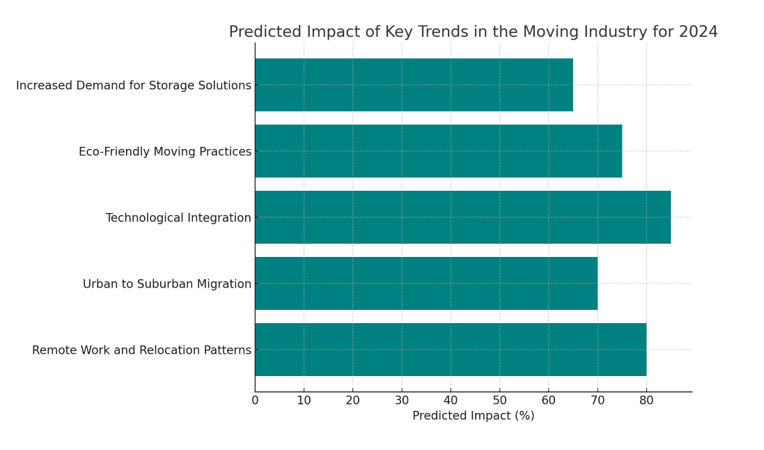
Published on 08/06/2024
Published on 08/06/2024
The moving industry has experienced significant shifts in recent years, influenced by global events, technological advancements, and changing consumer preferences. As we look ahead to moving trends and predictions in 2024, it’s important to understand the current landscape of the moving industry 2024. In this article, we will explore the key factors shaping the moving industry today, highlight emerging trends, and make predictions for the year ahead.
The moving industry, a critical sector supporting residential and commercial relocations, has been adapting to a rapidly changing world. Factors such as the COVID-19 pandemic, economic fluctuations, and technological innovations have reshaped how moving companies operate and how customers approach their moves. From increased demand for local moves to a growing emphasis on eco-friendly practices, the industry continues to evolve to meet new challenges and opportunities.

The shift to remote work has significantly impacted the moving industry. As more companies adopt flexible work arrangements, many employees are relocating from urban centers to suburban or rural areas. This trend has led to an increase in local moves and a shift in demand for moving services. According to Ryan Carrigan, founder of moveBuddha, “With soaring home costs, many homeowners are staying put. It is renters and those who are downsizing that are driving the majority of moves, often moving with fewer belongings” (moveBuddha).
The rise of remote work has also driven migration from densely populated urban areas to suburban and rural regions. This shift is motivated by factors such as the desire for more space, lower living costs, and a better quality of life. The National Association of Realtors reports a continued trend of moving towards more affordable and spacious living environments, aligning with changes in the housing market (Horizon Moving Company) (www.top10.com).
Technology continues to play a crucial role in the evolution of the moving industry. From virtual estimates and digital inventory tracking to online booking and payment systems, technology has streamlined many aspects of the moving process. Companies that embrace these innovations are better positioned to offer efficient and customer-friendly services.

As environmental consciousness grows, more consumers are seeking eco-friendly moving options. Companies are increasingly adopting green practices, such as using reusable packing materials and energy-efficient vehicles. The emphasis on sustainability is not only reducing the environmental impact of moves but also attracting eco-conscious customers (Shleppers) (Two Twigs Moving).
With changing living arrangements and lifestyles, there is a rising demand for storage solutions. Whether due to downsizing, temporary relocations, or simply needing extra space, consumers are seeking flexible and secure storage options. Moving companies are expanding their services to include long-term and short-term storage facilities.
To provide a visual summary, the following infographic illustrates the predicted impact of these key trends on the moving industry in 2024:


The trend of remote work is expected to continue, leading to sustained demand for local and long-distance moving services. As employees have more flexibility in choosing where to live, moving companies may see an increase in relocations to previously less-populated areas.
As environmental awareness grows, more moving companies are likely to adopt green initiatives. Expect to see an increase in eco-friendly packing materials, electric moving vehicles, and partnerships with environmental organizations for carbon offset programs.
Technology will continue to enhance the customer experience in the moving industry. Innovations such as AI-driven customer service, real-time tracking of moving trucks, and comprehensive mobile apps will become more common, providing customers with greater convenience and transparency.
Consumers are increasingly seeking personalized moving experiences. In 2024, moving companies will likely offer more customized services, catering to specific needs such as senior moving, pet transport, and delicate item handling.
The moving industry may see increased competition, with new entrants leveraging technology and innovative business models. Additionally, consolidation among smaller companies may occur as businesses seek to expand their service offerings and market reach.
To provide a visual overview, the following infographic highlights the expected growth and focus areas in the moving industry for 2024:


The moving industry is poised for continued transformation in 2024, driven by changing consumer behaviors, technological advancements, and environmental considerations. By staying informed about these trends and adapting to new challenges, moving companies can better serve their customers and thrive in an evolving market. Whether you’re planning a move or operating in the industry, keeping an eye on these developments will be key to success.
 Top 10 Challenges During a Move and How to Overcome Them
Top 10 Challenges During a Move and How to Overcome Them
Discover top moving challenges and learn practical tips to overcome moving obstacles. Moving tips and solutions for a stress-free move.
Read more How Moving Habits Have Changed Post-Pandemic
How Moving Habits Have Changed Post-Pandemic
Explore how moving habits have changed post-pandemic, with insights on moving trends after COVID-19. Discover the shifts in moving post-pandemic as remote work and lifestyle choices reshape the industry.
Read more Steps to Take Before Moving in Retirement
Steps to Take Before Moving in Retirement
Expert Tips On How to Prepare For a Stress-Free Retirement Move
Read more